Mountains create ideal places for sacred sites, serving either as pilgrimage destinations or temple locations. The remoteness of a mountain from everyday life and its height give devotees a sense of nearness to heaven. Therefore, almost every nation has built their national and religious centre on a mountain. Consider some of the following examples:
Asian Sacred Mountains
Burkhan Khaldun (Бурхан Халдун)
Burkhan Khaldun holds the tomb of Genghis Khan,who declared this to be Mongolia’s most sacred mountain. Genghis Khan worshiped regularly on Burkhan Khaldun. Today, Mongolians undertake regular pilgrimage to the three sacred major ovoos along a specified route around Burkhan Khaldun. Thus it represents the “heritage and traditional ways of life of nomadic people of Mongolia” (wiki).
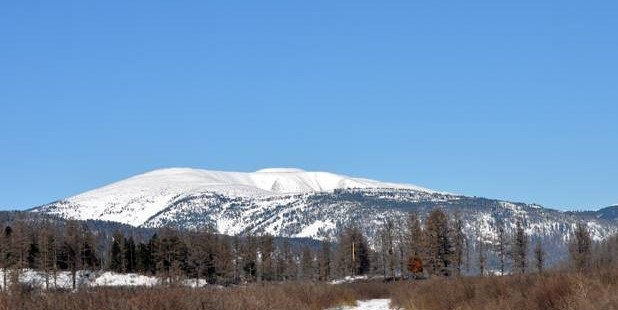
Ganzorig Gavaa, CC BY-SA 2.0, via Wikimedia Commons
Adam’s Peak
Sri Lankan Sinhalese Buddhists reference Adam’s Peak as one of their most sacred sites. The summit contains a natural formation believed to be a footprint of Buddha (Sri Pada or ශ්රී පාද). Thus pilgrims take pilgrimage up the mountain, following a variety of difficult routes up thousands of steps (wiki).
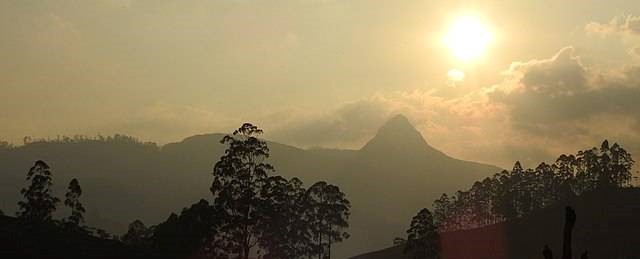
Rehman Abubakr, CC BY-SA 4.0, via Wikimedia Commons
Phnom Kulen (ភ្នំគូលែន)
Both Cambodian Hindus and Buddhists make pilgrimage to Phnom Kulen, considering it as the birthplace of the ancient Khmer Empire. The founder of the Khmer dynasty declared his divine right to rule (devaraja) at Phnom Kulen. Nearby is Preah Ang Thom, a Buddhist monastery with the country’s largest reclining Buddha statue (wiki).
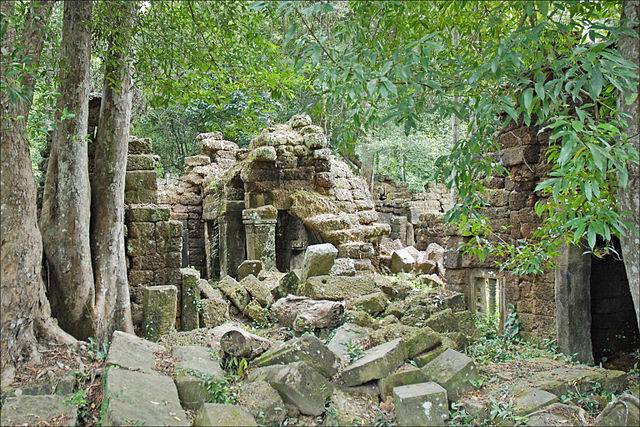
dalbera, CC BY 2.0, via Wikimedia Commons

Narith5, CC BY 2.0, via Wikimedia Commons

Stefan Fussan, CC BY-SA 3.0, via Wikimedia Commons
Paektu Mountain (백두산; 白頭山; 长白山; 長白山)
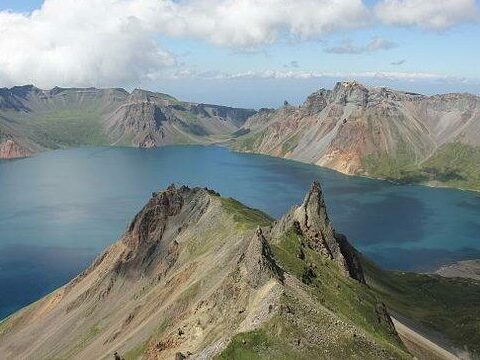
Laika ac, CC BY-SA 2.0, via Wikimedia Commons
Also called Baekdu Mountain, and sacred to both Koreans and Chinese, Paektu Mountain sits on the China-North Korea border. A volcano with a lake atop its crater, Koreans assign a mythical quality to the volcano and its lake. Calling it Heaven Lake, they consider it to be their country’s spiritual home. Both South and North Korea’s national anthems mention Paektu. The national emblem of North Korea depicts Paektu, calling it “the sacred mountain of the revolution.” Manchu Chinese regard Changbai (as they call it) as their sacred ancestral homeland. They used it to symbolize the Qing Dynasty’s imperial power (wiki).
Doi Suthep (ดอยสุเทพ)
Doi Suthep, outside of Chiang Mai in Thailand, contains the temple Wat Phra That Doi Suthep. Devout Thai Buddhists view this temple as an important venue for worship (wiki).
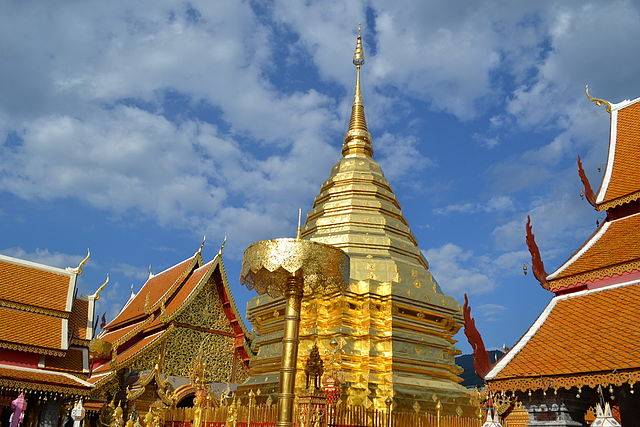
เทวประภาส มากคล้าย, CC BY 3.0, via Wikimedia Commons

Millevache, CC BY-SA 3.0, via Wikimedia Commons
The Three Holy Mountains (三霊山, Sanreizan)
The three holy mountains of Japan are:
- Mount Fuji or Fugaku (富士山),
- Mount Tateyama (立山),
- Mount Hakusan (白山).
They feature in Japan creation stories. Culturally, Japanese consider that various deities dwell in these mountains. Thus these mountains contain shrines and devotees regularly make pilgrimage to the shrines and mountain peaks (wiki).
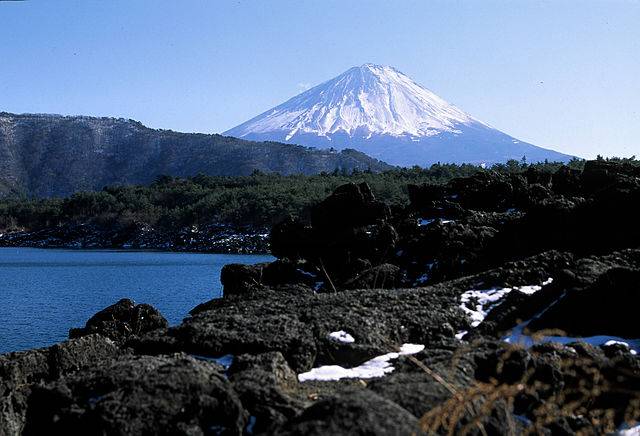
Fg2, Public domain, via Wikimedia Commons
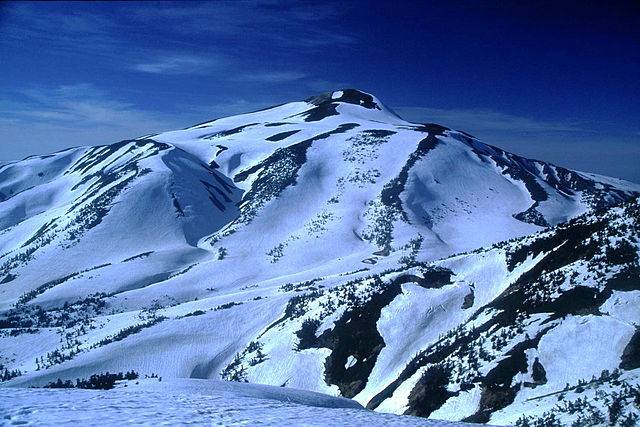
Alpsdake, Public domain, via Wikimedia Commons

Alpsdake, CC BY-SA 4.0, via Wikimedia Commons
Mount Kōyasan (高野山)
Mount Koyasan contains a large temple complex of Shingon Buddhist temples, which receives over a million Japanese pilgrims every year. The most well-known temples there are Kongōbu-ji (金剛峯寺) and Danjogaran (壇上伽藍) (wiki).
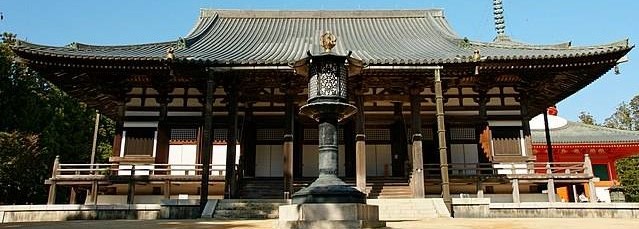
Laika ac, CC BY-SA 2.0, via Wikimedia Commons
These Great mountains refer to the five mountains where emperors made pilgrimage to the Supreme God of Heaven. Emperors of all dynasties through Chinese history undertook pilgrimages to these Five. They are:
- East Great Mountain: Tài Shān (泰山)
- West Great Mountain: Huà Shān (华山; 華山)
- South Great Mountain: Héng Shān (衡山)
- North Great Mountain: Héng Shān (恒山; 恆山)
- Center Great Mountain: Sōng Shān (嵩山)
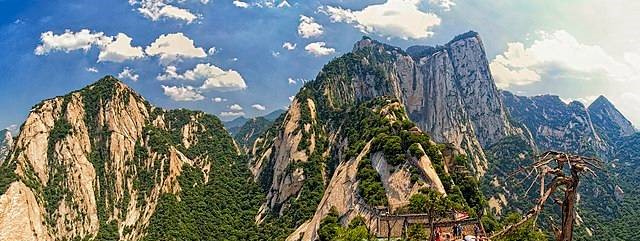
chensiyuan, CC BY-SA 4.0, via Wikimedia Commons
In addition, China has sacred mountains for Buddhist, Zen and Taoist Temples.
The Mountain Made Sacred Internationally for All
These mountains were intended to be sacred for the nation that lived by its slopes. But what about a mountain planned to be sacred for all nations on the planet?
We see this in the ancient Hebrew Scriptures, which selected a specific mountain for such a role long ago. This mountain area comes regularly into the international news today, affecting all our lives. How did this mountain, located thousands of kilometers away from where you live, obtain such a status? It started with a dramatic ritual thousands of years ago, the results of which still echo today. How this occurred we explore here.
The Mountain Sign of Abraham’s Sacrifice
We saw how the Creator God promised to bless Abraham. He also promised that His blessing would flow through Abraham to all nations. Because Abraham trusted this promise, God credited him righteousness. So Abraham received righteousness, a vimutti, or liberation, from samasara, as a free gift.
Later, Abraham received that long awaited son, Isaac (from whom Jews today trace their ancestry). Isaac grew into a young man. But then God tested Abraham with a shocking demand. You can read the complete account here. We will go over the key details to unlock the meaning of this test. It revealed the mystery of how karma would be paid for.
Abraham’s Test
This test started with a dire command:
2 Then God said, “Take your son, your only son, whom you love—Isaac—and go to the region of Moriah. Sacrifice him there as a burnt offering on a mountain I will show you.”
Genesis 22:2
Abraham, in obedience to the command ‘got up early next morning’ and ‘after three days travel’ reached the mountain. Then:
9 When they reached the place God had told him about, Abraham built an altar there and arranged the wood on it. He bound his son Isaac and laid him on the altar, on top of the wood. 10 Then he reached out his hand and took the knife to slay his son.
Genesis 22:9-10
Abraham moved to obey the command. But then something remarkable happened:
11 But the angel of the Lord called out to him from heaven, “Abraham! Abraham!”
“Here I am,” he replied.
12 “Do not lay a hand on the boy,” he said. “Do not do anything to him. Now I know that you fear God, because you have not withheld from me your son, your only son.”
13 Abraham looked up and there in a thicket he saw a ram caught by its horns. He went over and took the ram and sacrificed it as a burnt offering instead of his son.
Genesis 22:11-13
At the last moment, Isaac was saved from death and Abraham saw a male sheep, sacrificing it instead. God had provided a ram and the ram took the place of Isaac.
The Sacrifice: Looking to the Future
Abraham then names that place. Notice what he names it.
14 So Abraham called that place The Lord Will Provide. And to this day it is said, “On the mountain of the Lord it will be provided.”
Genesis 22:14
Abraham named it ‘The LORD will provide’.
The Name: Past, Present, or Future Tense?
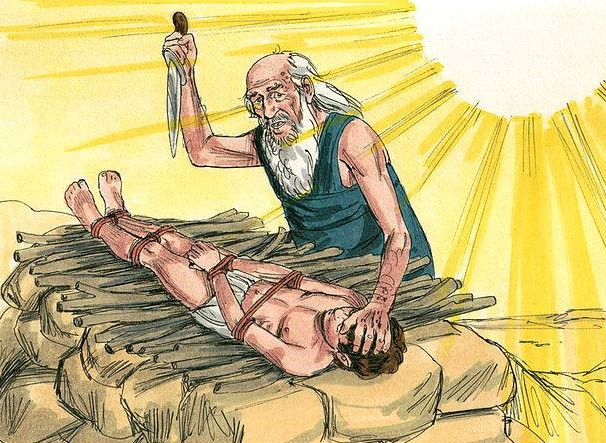
Sweet Publishing, CC BY-SA 3.0, via Wikimedia Commons
It is clearly in the future tense. To remove all doubt the comment which follows repeats “On the mountain of the LORD it will be provided.” This is again in the future tense – thus also looking to the future. Could Abraham have referred to the ram caught in the thicket and sacrificed in place of his son? But that ram was already sacrificed and burned when Abraham named the place. If Abraham was thinking of that ram – already dead, sacrificed and burnt – he would have named the place ‘The LORD has provided’. In other words, he would have named it in past tense. And the comment would read: “On the mountain of the LORD it was provided.”
Abraham clearly named it in future tense and therefore was not thinking of that already dead and sacrificed ram. He was enlightened to something different. He had insight into something about the future.
But what?
The Mountain of the Sacrifice
Remember that the mountain where God directed Abraham for this sacrifice was:
2 Then God said, “Take your son, your only son, whom you love—Isaac—and go to the region of Moriah…”
Genesis 22:2
This happened in ‘Moriah’. Where is that? It was a wilderness area in Abraham’s day (2000 BCE). But a thousand years later (1000 BCE), King David established the city of Jerusalem there. And his son Solomon built the First Jewish Temple there. We read later in the Hebrew Scriptures that:
1 Then Solomon began to build the temple of the Lord in Jerusalem on Mount Moriah, where the Lord had appeared to his father David. It was on the threshing floor of Araunah the Jebusite, the place provided by David.
2 Chronicles 3:1
In other words, ‘Mount Moriah’ in the ancient time of Abraham (2000 BCE) existed as an isolated wilderness mountain top. But 1000 years later, David, the first King, located Jerusalem there. Then his son, Solomon built the First Temple to the Creator there. Today Jerusalem remains a holy place for the Jewish people and serves as the capital of Israel. It has also become one of the most contested mountains on the planet.
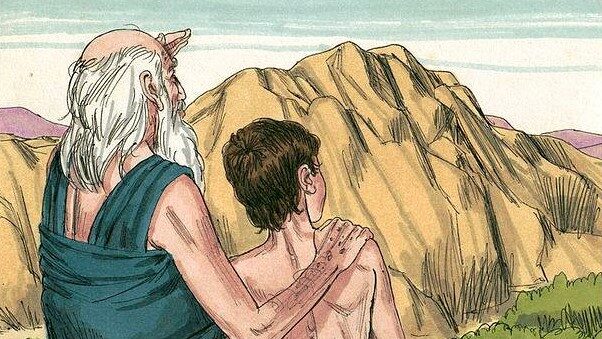
Sweet Publishing, CC BY-SA 3.0, via Wikimedia Commons
Jesus and the Sacrifice of Abraham
Think now about the many titles of Jesus in the New Testament. His most well-known title is ‘Christ’. But he carried another equally important title. We see this in the Gospel of John when John the Baptist says of him:
29 The next day John saw Jesus coming toward him and said, “Look, the Lamb of God, who takes away the sin of the world!
John 1:29
In other words, Jesus carried the title ‘The Lamb of God’. Now consider the end of Jesus’ life. He was arrested and crucified in Jerusalem. The Gospels very clearly states about his arrest that:
7 When he learned that Jesus was under Herod’s jurisdiction, he sent him to Herod, who was also in Jerusalem at that time.
Luke 23:7
The arrest, trial, and crucifixion of Jesus happened in Jerusalem (Mount Moriah). The timeline below shows the events in ancient history that have happened at Mount Moriah:

Now think back to Abraham. Why did he name that place using future tense ‘The LORD will provide’? The future tense indicated that the test he underwent there would replay in some way. More was to come.
Think about it! In Abraham’s test, Isaac (his son) was saved from death at the last moment because God provided a lamb to be sacrificed in his place. Two thousand years later, Jesus adopts the title ‘Lamb of God’. Then he is sacrificed on the same spot! Two lambs, separated by two thousand years, were sacrificed on the same spot. How did Abraham know this would be ‘the spot’? Humans do not know the future, especially thousands of years ahead. He could only have known and foreseen something that remarkable if he had received enlightenment from the Creator God himself.
A Divine Mind is Revealed
A Mind connected these two events by location even while they were separated by 2000 years of time.

The figure above illustrates how the earlier event (Abraham’s sacrifice) alludes to the later one (Jesus’ sacrifice). The earlier event, by use of future tense, pointed to the later event. This provides evidence that this Mind (Creator God) revealed His Plan by coordinating events separated by thousands of years. It serves as a Sign that God spoke through Abraham.
Good News for You and Me
This account also pertains to us for more personal reasons. To conclude, God declared to Abraham that:
18 “And through your offspring all nations on earth will be blessed, because you have obeyed me.”
Genesis 22:18
You belong to one of ‘all nations on earth’ – no matter your language, religion, education, age, gender, or wealth! That means God promised a blessing specifically for you. This was not solely for Abraham or the Jews, but for people all over the world.
How would God give this blessing? The blessing would come ‘through your offspring‘. The word ‘offspring’ here is in the singular. It is not ‘offsprings’ as in many descendants or peoples. It is not through many people or a group of people as in ‘they’. Rather, the blessing would come through a ‘he’. This follows exactly the promise from the beginning of history when a ‘he’ would ‘strike the heel’ of the serpent.
This test predicted the very place of the sacrifice, Mount Moriah (Jerusalem), giving further detail to this ancient promise. The details of Abraham’s sacrifice reveal how this blessing is given, and how the price for righteousness would be paid.
How Is the Blessing of God Obtained?
The ram saved Isaac from death by being sacrificed in his place. In the same way, the Lamb of God, by his sacrificial death, saves us from the power and penalty of karma and death. The Bible declares that:
23 For the wages of sin is death…
Romans 6:23
This means that the sins we undergo result in karma, leading to death. But death was paid by the lamb substituting for Isaac. Abraham and Isaac simply had to accept it. He did not and could not merit it. But he could receive it as a gift. This is exactly how Abraham found liberation.
This reveals the pattern for us. Jesus was the ‘Lamb of God who takes away the sin of the world’. This includes your sin along with its karma. So Jesus offers to pay for your sin since he made the payment. You cannot merit this, but you can receive it as a gift. His sacrifice gives him that power. We know this because it was predicted beyond coincidence in the remarkable account of the sacrifice of Abraham’s son on Mount Moriah, the same spot where 2000 years later it ‘was provided’ by Jesus.
The foretelling of when this would happen follows in the Sign of the New Year Passover Festival.